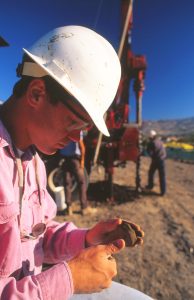Green building starts with sustainable ground conditions.
What is Green Building?
Green building is a practice of design. It focuses on environmentally responsible and resource efficient processes to reduce a building’s impact on humans and the environment during its lifetime. Efficient utilization of water, energy, building materials, and natural resources are significant to the goals of green building and the U.S. Green Building Council (USGBC). Reducing waste and the consumption of natural resources during and after construction is sustainably crucial. These concepts challenge designers to seek out creative, and green, solutions.
From a geotechnical and construction materials viewpoint, many areas incorporate sustainability into the green building process. For example, taking advantage of natural site topography, favorable soil, and groundwater conditions enhance green projects. Recycled-content from existing construction materials and incorporated into the new facility make a positive impact. There is much more, too.
While these actions result in definite benefits from an environmental aspect, they also present technical challenges.
Stormwater
Stormwater mandates by local and state agencies reduce or eliminate the amount water allowed to flow off a site. Thus, on-site storage and disposal are critical. Underground detention basins, dry wells, permeable pavers and leach fields require subsurface improvements. Stormwater must infiltrate into the soil. For sites with quality designs and suitable soil conditions, these systems impart a considerable benefit to a project by allowing non-visible stormwater disposal while increasing the available space for landscaping, pedestrian use, or parking.
Theoretically, these systems are perfect solutions to project water woes. However, before implementation, several aspects are taken into account. Systems in proximity to foundations can lead to saturation of the surrounding soil. That might eventually reduce the strength of soils intended to support the building’s foundation. So, placement within the surrounding topography is essential. They should not go near slopes or improvements where the introduction of subsurface water is detrimental. For example, systems at the top lead to slope failure if soils become saturated.
Also, subsurface soil conditions need investigation before utilizing a subsurface system. Fine-grained soils (i.e., clays and silts) don’t allow infiltration of water, while coarse-grained soils (such as mixtures of sand and gravel) allow water to infiltrate back into the ground. Geoprofessionals provide the necessary geotechnical guidance in the development of on-site stormwater disposal systems relative to the site conditions.
Grading and Foundations
Reducing the size of a building’s footprint and the amount of disturbance promote green building concepts. Soil and bedrock conditions often dictate the amount of earthwork and foundation types needed for development. So, a geotechnical investigation is a crucial part of the design.
For instance, loose or soft soil sites are often over-excavated and recompacted to specified depths to mitigate settlement potential. If this approach is not consistent with the desired design, engineers seek alternatives such as a reduction in the building footprint with an increase in height or an alternative foundation such as piles or a rigid mat.
Construction Materials
Recycled or construction waste materials enhance green projects. Utilizing recycled asphalt and concrete for an aggregate base, high fly ash concrete mixes, and grinding of roadway materials are time-proven methods to reduce a project’s impact on the environment.
Portland cement is the most common type of cementitious material used in concrete. But, the transport and manufacture of Portland cement are energy intensive. An alternative cementitious material is fly ash. It is a waste product of the coal industry. So, replacing a percentage of Portland cement with fly ash in concrete mixes is a relatively easy way to use a waste material in the construction process. Fly ash:
- increases workability;
- overall ultimate concrete strength;
- (generally) costs less than Portland cement;
- improves concrete resistance to sulfate attack; and,
- reduces the heat of hydration.
However, drawbacks include increased time for the concrete to cure and sometimes lower early strengths, which can slow the construction process.
Recycled Construction Materials
There are many recycled construction materials associated with civil site development including an aggregate base, asphalt, and erosion control products. Recycling existing pavement materials at a project site, such as grinding asphalt concrete to be used as an aggregate base, reduces the need for virgin materials. It ultimately increases a project’s sustainable, green nature.
Sustainable Ground
Green building techniques in the field of geotechnical and materials engineering continue to evolve with new products and concepts. Sustainable design practices are becoming common as the public places a higher value on environmental stewardship and efficiency. Earth Systems is committed to an active role in sustainable development, continuing education, listening to clients needs, and adapting to new ideas and concepts that are important for the future of our profession, and ultimately, our planet.
In addition, Earth Systems was featured in an article titled Ground Conditions Sustainable in Green Building & Design (GB&D) magazine here.
Note: Earth Systems originally published this article in a newsletter in 2009 and re-edited it for the web.








